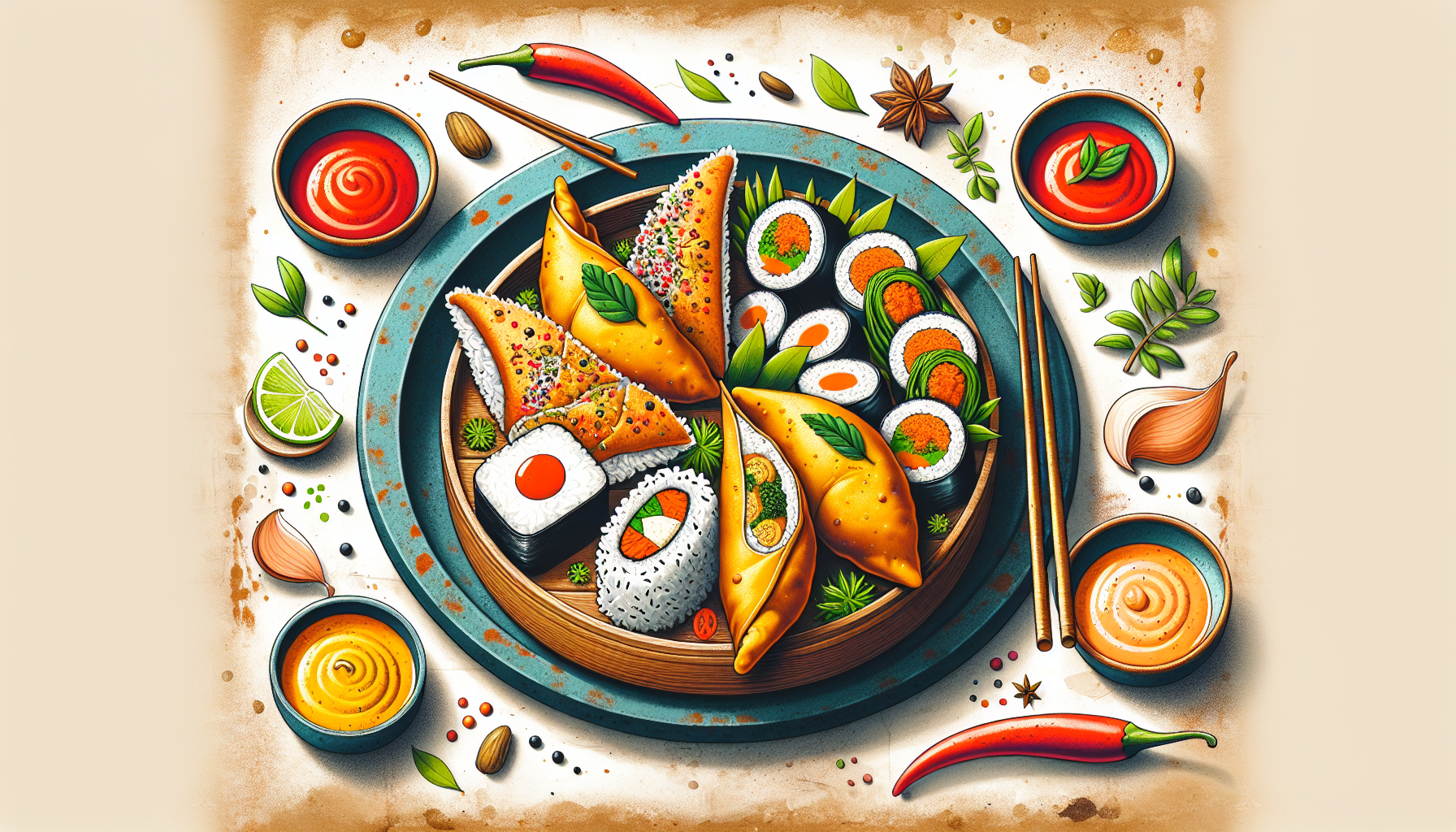Step into the vibrant world of Indian cuisine and prepare to be amazed by the incredible concoctions of flavors and tastes that await you. India, known for its rich culinary traditions, has a long-standing tradition of experimenting with food, resulting in the creation of Fusion Cuisine. From blending traditional Indian ingredients with international flavors to infusing traditional dishes with innovative twists, Indian chefs have managed to create a unique culinary experience that showcases the cultural diversity and creativity of the country. Come along on a journey through the tantalizing world of Fusion Cuisine, where old meets new and boundaries are pushed in the pursuit of culinary perfection.

History of Indian Cuisine
India is a country known for its rich culinary traditions and diverse flavors. The history of Indian cuisine is fascinating and dates back thousands of years. Indian cuisine has been influenced by various cultures, and it has evolved through the years to become the vibrant and flavorful cuisine we know today.
Origins of Indian Cuisine
The origins of Indian cuisine can be traced back to the Indus Valley Civilization, which existed around 2500 BCE. The people of this ancient civilization were engaged in agricultural practices and relied heavily on the use of spices. The use of spices in Indian cuisine can be attributed to this early period.
Over the centuries, Indian cuisine was influenced by different cultures such as the Persian, Mughal, and British. These influences have contributed to the diverse range of flavors and techniques found in Indian cooking.
Influence of Different Cultures on Indian Cuisine
The Persian influence on Indian cuisine can be seen in the form of dishes like biryani and kebabs. The Mughals, who ruled India from the 16th to the 19th century, introduced intricate cooking techniques, rich gravies, and the use of dried fruits and nuts in their dishes. The British colonization of India also left an indelible mark on Indian cuisine, introducing ingredients such as potatoes, tomatoes, and chili peppers.
These cultural influences have shaped Indian cuisine and created a unique fusion of flavors and cooking styles. Indian cuisine is a true reflection of the country’s diverse history and cultural heritage.
Evolution of Indian Cuisine Through the Years
Indian cuisine has undergone significant changes and evolved over the years. The introduction of new ingredients, cooking techniques, and cultural influences have all contributed to this evolution. Traditional Indian cuisine varies from region to region, with each region having its own specialty dishes.
Traditional Indian Cuisine
Traditional Indian cuisine is known for its bold flavors, vibrant colors, and aromatic spices. Each region in India has its own unique culinary traditions and specialties.
Regional Specialties in Indian Cuisine
India is a country of diverse cultures, and this diversity is reflected in its cuisine. Each region in India has its own specialty dishes that are influenced by the local ingredients and cooking techniques. For example, in the north, dishes like butter chicken and naan are popular, while in the south, one can find delicacies like dosa and idli.
The coastal regions of India, such as Goa and Kerala, are known for their seafood dishes, while the states of Rajasthan and Gujarat are famous for their vegetarian cuisine. The eastern part of India, including West Bengal and Odisha, is known for its sweets and seafood dishes.
Common Ingredients in Indian Cuisine
Indian cuisine makes use of a wide range of ingredients, including spices, grains, vegetables, and dairy products. Commonly used ingredients include rice, wheat, lentils, chickpeas, turmeric, cumin, coriander, ginger, garlic, onions, and tomatoes.
Dairy products like ghee (clarified butter), yogurt, and paneer (Indian cottage cheese) are also essential elements of Indian cuisine. These ingredients come together to create the distinct flavors and textures that are characteristic of Indian dishes.
Spices Used in Indian Cooking
Spices are the heart and soul of Indian cuisine. Indian cooking is known for its bold and intense flavors, and spices play a crucial role in achieving this. Some of the commonly used spices in Indian cooking include cumin, coriander, turmeric, cardamom, cinnamon, cloves, and chili powder.
These spices not only add flavor to the dishes but also have various health benefits. They are known for their anti-inflammatory properties, antioxidant properties, and ability to aid digestion. The correct balance of spices is essential in Indian cooking to ensure that the flavors are well-balanced and harmonious.

The Concept of Fusion Cuisine
Fusion cuisine is a culinary concept that combines elements of different culinary traditions to create a new and unique culinary experience. It brings together flavors, cooking techniques, and ingredients from different cultures to create innovative dishes.
Definition of Fusion Cuisine
Fusion cuisine is all about blending different culinary traditions and creating something new and exciting. It involves taking ingredients and techniques from different cuisines and fusing them together to create a harmonious and innovative dish. Fusion cuisine is not limited by boundaries and allows chefs to experiment and push the boundaries of traditional cooking.
How Fusion Cuisine Emerged in India
The concept of fusion cuisine emerged in India as a result of cultural exchanges and the country’s diverse culinary heritage. With its long history of influences from different cultures, India became the perfect breeding ground for fusion cuisine.
Chefs in India started experimenting with different flavors, techniques, and ingredients from around the world to create unique and innovative dishes. This led to the birth of fusion cuisine in India, where traditional Indian flavors were combined with elements from other cuisines to create exciting new dishes.
Influence of Globalization on Fusion Cuisine
Globalization has played a significant role in the popularity and development of fusion cuisine in India. With increased travel and exposure to different cultures, people have become more adventurous and open to trying new flavors and combinations. This has led to a growing demand for fusion cuisine in India.
The influence of globalization can be seen in the increasing availability of international ingredients, the rise of international food chains, and the growing popularity of fusion restaurants. Fusion cuisine has become a way for people to experience different cultures and flavors without leaving their own city.
Fusion Cuisine in India
Fusion cuisine has gained immense popularity in India and has become a significant part of the culinary landscape. It has given rise to unique dishes that showcase the creativity and innovation of Indian chefs.
Popular Fusion Dishes in Indian Cuisine
In India, there are numerous popular fusion dishes that have become favorites among food enthusiasts. One such example is the “butter chicken pizza,” which combines the flavors of traditional Indian butter chicken with the concept of a pizza. Another popular fusion dish is the “sushi dosa,” which merges the Japanese delicacy of sushi with the South Indian staple of dosa.
Indian-Chinese fusion dishes like “gobi Manchurian” (cauliflower fritters in a spicy sauce) and “chicken lollipop” (chicken wings marinated in a Chinese-style sauce) have also gained a huge following in recent years. These dishes showcase the unique blend of flavors and techniques that fusion cuisine offers.
Origins and Inspiration Behind Fusion Dishes
Fusion dishes in Indian cuisine are often inspired by the desire to create something new and exciting. Chefs draw inspiration from their cultural heritage, travel experiences, and exposure to different cuisines to come up with innovative combinations.
For example, the “vada pav burger” is a fusion of the quintessential Mumbai street food, vada pav, and the popular fast-food item, the burger. Chefs saw an opportunity to reimagine the vada pav in a new avatar by incorporating it into a burger, creating a unique fusion dish.
Impact of Fusion Cuisine on Traditional Indian Recipes
The rise of fusion cuisine has had a significant impact on traditional Indian recipes. While some purists argue that fusion cuisine dilutes the authenticity of traditional dishes, others see it as a way to breathe new life into traditional recipes and attract a broader audience.
Fusion cuisine has introduced new flavors, ingredients, and techniques into traditional Indian recipes, making them more exciting and appealing to the modern palate. It has also helped in reviving traditional dishes that were losing popularity by giving them a contemporary twist.

Innovative Indian Fusion Restaurants
The popularity of fusion cuisine in India has given rise to a new breed of innovative fusion restaurants. These restaurants offer a unique dining experience, with dishes that combine the best of different culinary traditions.
Introduction to Innovative Fusion Restaurants
Innovative fusion restaurants in India are known for their creative menus, imaginative presentation, and unique flavor combinations. They are breaking the traditional boundaries of Indian cuisine and offering diners a chance to experience new and exciting flavors.
These restaurants often have a blend of traditional and modern elements in their ambiance and décor, creating a welcoming and trendy atmosphere. They are frequented by both locals and tourists looking for a dining experience that goes beyond traditional boundaries.
Famous Fusion Restaurants in India
Some of the most famous fusion restaurants in India have gained nationwide recognition for their innovative approach to fusion cuisine. One such restaurant is “Indian Accent” in New Delhi, which is known for its inventive dishes that combine Indian flavors with international techniques.
“Molecular Gastronomy,” a restaurant in Kolkata, is another popular fusion restaurant that offers a unique dining experience. It uses modern cooking techniques and presentation styles to create visually stunning and delicious dishes.
Unique Fusion Dishes Created at These Restaurants
The innovative fusion restaurants in India are known for their unique and creative dishes that push the boundaries of traditional cooking. These dishes showcase the culinary skills and imagination of the chefs.
For example, “Indian Accent” offers dishes like “Meetha Achar Pork Ribs,” which combines the flavors of Indian pickles with succulent pork ribs. Another unique dish is the “Prawn Balchao Hummus,” which blends the Goan-style prawn balchao with the Middle Eastern classic hummus.
The fusion dishes created at these restaurants take inspiration from various culinary traditions and offer a fresh and exciting take on Indian cuisine.
Challenges and Criticisms
While fusion cuisine has gained popularity in India, it has also faced its fair share of challenges and criticisms.
Balancing Authenticity and Innovation in Fusion Cuisine
One of the main challenges in fusion cuisine is finding the right balance between authenticity and innovation. Critics argue that some fusion dishes stray too far from their original roots and lose the essence of their traditional flavors.
Chefs must navigate this fine line, ensuring that their fusion creations respect the integrity of the original dish while adding a new dimension to it. It is essential to preserve the essence of traditional Indian cuisine while embracing innovation and creativity.
Criticism of Fusion Cuisine in India
Fusion cuisine has not been immune to criticism in India. Some critics argue that fusion dishes lack authenticity and are mere gimmicks aimed at attracting attention. They believe that fusion cuisine dilutes the cultural heritage and tradition of Indian cooking.
However, proponents of fusion cuisine argue that it reflects the evolving tastes and preferences of a multicultural society. They believe that fusion cuisine is an expression of creativity and innovation and should be seen as a natural progression in the culinary world.
Challenges Faced by Chefs in Creating Fusion Dishes
Creating fusion dishes comes with its own set of challenges for chefs. They must have a deep understanding of the culinary traditions they are drawing from and ensure that the flavors and techniques complement each other.
Moreover, sourcing the right ingredients can be a challenge, especially when working with international flavors. Chefs often have to find substitutes for ingredients that are not readily available in their local markets.
Despite these challenges, chefs continue to experiment with fusion cuisine, pushing the boundaries of traditional cooking and offering diners a unique and memorable culinary experience.
Evolution of Fusion Cuisine
The fusion cuisine scene is constantly evolving, with chefs and restaurateurs pushing the boundaries of creativity and experimentation.
Changing Trends in Fusion Cuisine
Fusion cuisine is a dynamic and ever-evolving field. The trends in fusion cuisine change with time, reflecting the shifting tastes and preferences of diners.
One current trend is the incorporation of healthy and organic ingredients into fusion dishes. Chefs are using locally sourced, sustainable ingredients to create dishes that are both delicious and good for the body.
Another trend is the fusion of traditional Indian flavors with Western cooking techniques, such as sous vide or molecular gastronomy. These techniques add a modern twist to traditional dishes, creating a fusion of flavors and textures.
New Experimental Techniques in Fusion Cooking
With advancements in technology and cooking techniques, chefs are constantly exploring new ways to create unique fusion dishes. Techniques such as molecular gastronomy, sous vide, and foam are being used to create visually stunning and innovative dishes.
Chefs are also experimenting with unconventional flavor combinations, blending ingredients from different cuisines to create exciting and unexpected flavors. The use of ingredients like edible flowers, exotic fruits, and rare spices adds a touch of novelty to fusion dishes.
Future Prospects and Possibilities in Fusion Cuisine
The future of fusion cuisine in India looks bright, with endless possibilities for innovation and experimentation. As India continues to embrace globalization and cultural exchange, fusion cuisine will continue to evolve and capture the imagination of diners.
With the increasing popularity of international flavors and the growing culinary scene in India, fusion cuisine is poised to become even more popular in the coming years. Chefs will continue to push the boundaries of traditional Indian cooking and create new and exciting fusion dishes.
Promotion and Awareness
The growing popularity of fusion cuisine has led to the promotion and awareness of this culinary concept through various platforms and initiatives.
Food Festivals and Events Promoting Fusion Cuisine
Food festivals and events play a crucial role in promoting fusion cuisine in India. These events bring together renowned chefs, food enthusiasts, and industry professionals to showcase the latest trends and innovations in the culinary world.
Fusion cuisine is often a highlight at such events, with chefs presenting their unique fusion creations to a diverse audience. These festivals and events help create awareness about fusion cuisine and provide opportunities for collaboration and exchange of ideas.
Role of Social Media in Popularizing Fusion Dishes
Social media platforms like Instagram and YouTube have played a significant role in popularizing fusion dishes in India. Food bloggers, chefs, and home cooks share their creations and recipes, attracting a wide audience and creating a buzz around fusion cuisine.
Social media platforms also provide a platform for chefs and restaurants to showcase their fusion creations and attract customers. The visually appealing nature of fusion dishes makes them well-suited for platforms like Instagram, where food photography is highly popular.
Efforts to Preserve Traditional Indian Recipes Amidst Fusion Experiments
While fusion cuisine continues to gain popularity, there is a growing recognition of the importance of preserving traditional Indian recipes. Efforts are being made to document and preserve traditional cooking techniques, ingredients, and recipes.
Various organizations and institutions are working towards promoting traditional Indian cuisine and ensuring that it remains an integral part of the culinary heritage. These efforts help strike a balance between innovation and tradition and ensure that traditional Indian recipes do not get lost in the wave of fusion experiments.
Conclusion
Fusion cuisine has revolutionized the culinary landscape in India, offering a new and exciting way to experience the flavors of traditional Indian cooking. It has brought together diverse culinary traditions and allowed for creative experimentation and innovation.
While fusion cuisine has faced its fair share of challenges and criticisms, it has undoubtedly made a significant impact on Indian culinary traditions. It has showcased the creativity and imaginative spirit of Indian chefs and provided diners with an opportunity to explore new flavors and experiences.
The future of fusion cuisine in India looks promising, with endless possibilities for innovation and experimentation. As long as chefs continue to balance innovation with respect for tradition, fusion cuisine will continue to evolve and captivate food enthusiasts across the country.
